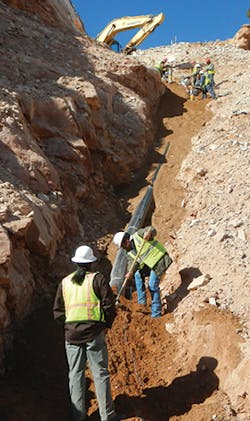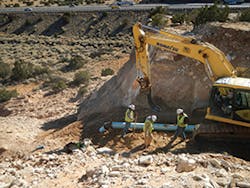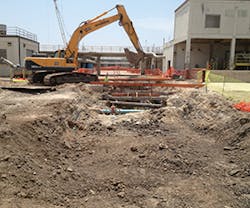Earlier this year a New Mexico contractor successfully completed laying 18.6 miles of water main, much 0of it in solid rock, and 6.8 miles of services lines on the Pueblo of Laguna Reservation for native Americans located west of Albuquerque, NM.
RMCI Inc., based in Albuquerque, began construction on the $6 million project in August 2012 and completed it last October. Approximately 80% of the pipelines were dug in solid rock, said RMCI project superintendent Mike Tinajero.
The project owner, the Pueblo of Laguna Council, had decided to repair and improve its dilapidated water system, which had broken in 2009, leaving two villages, three schools, and many governmental operations without water for 12 days. The council worked closely with the US Department of Agriculture’s Rural Development office in Albuquerque on funding strategies to address the situation.
The Pueblo submitted an application for the entire water project for a loan/grant with the USDA. Working together on this application and on phasing the project, the Pueblo secured an award totaling over $26 million in loan and grant funding to repair and improve the water systems in all six villages. Multiple contracts were issued to various contractors to perform the work.
RMCI assigned four crews to the $6 million project. Two mainline crews and two service line crews laid PVC and HDPE pipe at the peak of construction. “We started with the big pipe, the 12-inch, and worked our way down through the 10-inch, then the 6-inch and 8-inch,” said Tinajero. “The 4-inch installation came in the laterals running off the 12-inch and 10-inch pipe. All the water mains are force mains.”
Tinajero said RMCI mobilized two Komatsu PC-400 excavators, three Komatsu PC-300 excavators, three Komatsu PC-200 excavators, four John Deere 310 loader-backhoes, a Volvo EC480 excavator fitted with a 10,000-pound Allied model G 100 hammer, and three Volvo L120 loaders to lay the water main and service lines. The loader-backhoes were used to dig the service lines.
A typical mainline crew opened up the trench with a Komatsu PC-400, and a PC-300 and PC-200 would do the pipe installation and backfill. The mains were laid 5 to 6 feet deep, and RMCI sloped trench sides back at 1:1 and 1.5:1. No trench boxes were needed in the hard rock, which consisted of basalt and consolidated sandstone. Where needed, the Volvo EC480 and its Allied hydraulic hammer broke up the hardest rock.
“We used walk-behind jumping jacks and roller buckets on our smaller excavators to handle our compaction,” said Tinajero. “The roller buckets are a combination between a bucket and a roller wheel right behind the bucket. The Volvo L120 loaders moved backfill, moved rock, and unloaded and strung pipe.”
Because the backfill was so dry, RMCI used four 4,000-gallon water trucks-two for each mainline crew, to moisten the backfill and achieve 95% of maximum density on it. The trucks would water the backfill once when it was laid back beside the trench, and again when it was placed over the pipe. “We had to have 11 percent water in the backfill,” said Tinajero.
Over a Cliff
One of the project’s challenges was to lay pipe down an escarpment, or cliff, that was approximately 100 feet higher than the base elevation. “We had to bring in material and build a ramp from the bottom up so that we could get to the top and start digging our way back down,” said Tinajero. “The ramp reached a little more than three-quarters of the way to the top. We were able to sit our Komatsu PC-400 excavator up on top and have enough reach to start at the top and dig our way back down. That stretch was about 300 feet long and we dug 6 feet deep in rock.”
Tinajero said RMCI used a “shark bucket” to dig the rock wherever possible. The shark bucket has three different ripper points that are set at different offset angles. “For the escarpment we built our ramp from the bottom to the top and then laid pipe from the top down,” Tinajero said. “The ramp was built with excess spoils, rock, and excess dirt.”
For the escarpment RMCI fused together 12-inch HDPE pipe at the top of the cliff and pulled it down the hill. “We had a Komatsu PC-300 on top to start working it down, and once we got about three-quarters of the way down we had another PC-300 helping to pull the pipe,” Tinajero said. “We had no problems; it went very well.”
Another challenge was to work in tight spaces in the villages to place the 6-inch and 8-inch lines. “We had to go through 12- to 15-foot-wide alleys,” said Tinajero. “We had tight confined spaces in the villages where we installed mainlines through roadways with houses on each side. And we had to do a lot of vibration monitoring to make sure we didn’t cause any damage to the houses as we’re doing our line installation.”
When not working down the cliff, Tinajero said RMCI could average about 200 feet per day of pipe installed. “There were days when we did a lot more than that and days when we did a lot less,” he said. “It depended on the rock, the hardness of the rock. In the areas where we were able to dig, basically in the sandstone, we used the shark bucket. For anything in the volcanic basalt, we had to bring in the hammer and break it apart with that.”
The new water system will serve the villages of Old Laguna, Arrowhead Peak, Middle Mesita, Old Mesita, the Mesita Housing Area, and El Rito. The contract included 483 new water meter installations and more than 5,200 cubic yards of solid rock excavation.
Pipeline installation has reached the bottom of the cliff.
Design/Build Succeeds at Treatment Plant
Working under a $32-million-plus design-build contract, CH2M-Hill successfully upgraded and expanded the Robindale wastewater treatment plant in Brownsville, TX. Haskell, a designer-builder and contractor based in Jacksonville, FL, performed $11 million of the work as a subcontractor to CH2M-Hill.
Brownsville, located near the southern tip of Texas, has two wastewater treatment plants to serve a population of 175,000 persons. The Robindale plant was built in 1980 and expanded in 1995 to a capacity of 10 million gallons per day (mgd). Recently, it became evident that the plant needed to upgrade 30-year-old equipment and add capacity-an expansion to 14.5 mgd-to serve growth over the next 10 years.
Design-build is a progressive construction delivery method for Texas utilities. The Brownsville Public Utilities Board chose design-build for the Robindale plant for several reasons:
- It helped meet a deadline on discharge limits.
- The board could get several ideas early for how to use the existing plant, stretch dollars and meet water-quality limits.
- The board could have more control over plant equipment selection.
- Design-build allows the owner input on design until a guaranteed maximum price is delivered and approved.
The scope of CH2M-Hill’s work included expansion of the existing facility, new headworks, clarifiers, sludge digester, pump station, ultraviolet-light disinfection system, mixed liquor pump station, and the renovation of some existing package treatment plants.
“We have all the concrete and mechanical work,” says Jason Plauche, project manager for Haskell. “That means we built all the concrete structures, the headworks, mixed liquor pump station, the UV disinfection structure, all the yard piping, all of the above-grade mechanical piping, the large-diameter Hobas piping and more. Basically, we did everything except the prestressed concrete tanks, control systems integration, painting, coatings, electrical work and the site work packages.”
As you could imagine, the project required extensive pipe work, both above grade and underground. There were 48-inch ductile iron pipes, 42-inch ductile iron pipes, various PVC lines, and a total of 485 feet of large-diameter Hobas pipe. Hobas Pipe USA has been manufacturing centrifugally cast, fiberglass-reinforced, polymer mortar (CCFRPM) pipe at a Houston, TX, plant since 1987.
Haskell used a Hyundai 380LC excavator to dig trenches, along with trench boxes from United Rentals, to install the Hobas pipe. One run reached from the headworks to the existing facility, and it consisted of both 54-inch diameter pipe and 72-inch pipe. Another run, from the mixed liquor pump station to the aeration basin, was 72-inch pipe. A John Deere 644 wheel loader handled the backfilling chores. Both of the Hobas runs were gravity flow lines, buried 10 to 14 feet deep.
The soil was an impervious clay known in Texas as caliche. “It’s a corrosive soil, so we had to use cathodic protection to protect underground metal fittings,” says Plauche. “And if it rains, that caliche turns to slop, so it’s impossible to install anything while it’s raining.”
Haskell used sand bedding under the big pipes. And the John Deere loader brought the sandy clay backfill up in 8-inch lifts alongside the pipe. We asked Plauche if the Hobas pipe installation presented a challenge.
“Once we got going, it was pretty good to work with,” says Plauche. “The 72-inch pipe joints fitted right together. For the 54-inch, we had to get the manufacturer’s rep out there to help us, and they were a really good resource to utilize. Some joints will go together very easily, and some joints took a little longer, but you just had to work with them a little bit more. We used come-alongs and machinery to push it together. It was actually a pretty good system to put together.”
Haskell used a Hyundai 380LC excavator to lift pipe into place.
A New Kind of Carrier
Mike Crimaldi, president of Rig Source Inc., believes that the time has come for a new kind of rubber track carrier to serve the needs of pipeline contractors—a carrier that is truly customizable to fit individual requirements. He developed a rubber-track utility vehicle that can be customized according to the needs of the application. The traditional dumper is available, but the carrier can also serve as a mulcher, a mat carrier, a mobile epoxy coating machine, a hydroseeding unit, a mobile crane, a welding unit on tracks, a personnel carrier, a water tank carrier, or an offroad service vehicle.
Terramac, Crimaldi’s new company, is currently launching a line of North American-made rubber track carriers.
Pipeline contractors have been a key focus during this time due to the special conditions under which they must work.
“Contractors like the multiterrain capabilities of rubber track carriers. They also appreciate the fact that rubber
tracks don’t tear up the ground or road surface like steel track carriers, and they don’t leave ruts in delicate soil conditions
like wheeled vehicles,” explains Crimaldi. “Pipeline contractors started out using them to haul mats, but now
they use them for just about everything you can imagine.”
Like traditional rubber track carriers, the Terramac can still haul mats, but contractors are taking advantage of their
relatively minimal impact on the right of way and are using them for a wide range of applications. In fact, depending on
the size of the unit and its load, rubber track carriers may exert as little as 3 psi of pressure on the surface.
The company decided early on that the Terramac could ship without the standard dumper. Instead, the carrier is
equipped to accept whatever type of equipment the customer requires. In fact, Terramac will work directly with the original equipment manufacturer of the unit to be mounted to ensure that the bolt pattern of the carrier’s bed will match up perfectly.
The CE-certified Terramac RT9 has an 18,000-pound (8,200-kg) carrying capacity and is equipped with a 230-horsepower Cummins diesel engine in both open cab and closed cab options. The unit has rollover protective structure (ROPS) as well as falling-object protective structure (FOPS) components. Ground pressure when fully loaded is only 4.9 psi. The RT9’s easy front and rear bolt-on attachments accommodate a variety of needs in the pipeline, drilling and general construction industries.
Complex Intersection Calls for Patience
By late May of next year, residents of northern Illinois will be able to enjoy a completely rebuilt intersection at the corner of State Routes 176 and 31 in Crystal Lake. For a cost of $11 million, all four legs of the intersection will be widened to include two through lanes, two left turn lanes, and one right-turn lane.
Prime contractor R.W. Dunteman Inc. is also building a water detention pond and eliminating one street that fed into the intersection. Underground contractor JLA & Sons Construction is installing 173 runs of storm sewers ranging from 5 feet long to 227 feet long and putting in 185 storm drainage structures, including manholes, catch basins, and inlets.
Pavement at the intersection had deteriorated badly, and it was a bottleneck for traffic, especially on the east leg of Route 176, said Mark Chanwongse, resident engineer on the project for Cotter Consulting. The Illinois Department of Transportation hired Cotter to manage the project. The newly reconstructed intersection will accommodate more vehicles and population growth in the area.
The project was broken into two stages and is being built under traffic. The first stage was to shut down the east side of Route 31, which runs north and south, and to close the northern half of Route 176, which runs east and west. That stage has two phases: the first was to shut one side of Route 31 down, and the second was to close one side of Route 176. When storm sewers are fully installed under those sides of the roads and concrete pavement is placed, traffic will be flipped onto the new pavement and the other sides of the two routes will be closed and rebuilt.
When we visited the project in early July, JLA & Sons was early in stage one. One of three main storm sewer trunks, a line along 176, had been installed. That run consisted of 1,200 linear feet of concrete storm sewer ranging in diameter from 30 inches, through 27 inches, 24 inches, 21 inches, and finally 18-inch pipe in a stretch furthest from the intersection.
JLA & Sons used a John Deere 330C LC excavator with either a 30-inch bucket or a 60-inch bucket to dig the sewer trunk lines. The soil consisted of sand and gravel, with very little clay, said JLA’s project manager David Miller. Meanwhile a John Deere 624J loader handled excess spoils, brought backfill aggregate to the trench, and moved structures and pipe around the job site. A Hitachi 150 excavator helps compact backfill and digs laterals if space is tight, says Miller.
The second concrete trunk pipe to be installed runs along the east side
A Hyundai excavator works over a pipeline installation.
of Route 31. It is a 366-foot-long run that starts out at 36 inches and progresses gradually through smaller diameters to 18-inch pipe. The third and last section of trunk line runs along Route 176 and progresses from 24-inch concrete pipe to 15-inch pipe as it goes eastward away from the intersection. Storm sewer pipe typically gets 4 inches of bedding stone.
Four main catch basins or manholes will discharge stormwater to the new detention pond, said Chanwongse. “After the storm sewers are installed, we build the roadway back up again,” he says. The base consists of 12 inches of stone and the pavement will be 9.75 inches of concrete.
Construction was delayed by problems with relocating the maze of utilities that lay under the intersection. Originally completion was scheduled for August of 2013, but May of 2014 is the new completion date.The Volvo PL3005D pipelayer has a Volvo Tier 4i-certified engine. An anti-two block device automatically prevents hook/load block from making harsh contact. A planetary, high-pull winch delivers smooth lifting performance and precise control. The PL3005 provides performance in load positioning through 360 degrees of swing for maximum flexibility and precise load positioning.The PL3005 load management system enhances site safety and increases operator efficiency by communicating operating parameters. The versatility to convert the pipelayer to a conventional excavator further increases potential for utilization. The pipelayer has been designed to self-disassemble and reassemble, with no requirement of other lifting equipment, to ease machine transportation.
In its excavator-based configuration, the machine offers a 360-degree swing with full lifting performance and functionality at all radius positions—a solution unattainable with conventional sideboom pipelayers.
To increase productivity, the Volvo PL3005D allows for smooth, precise, and efficient load positioning anywhere around the machine, just like an excavator. These pipelayers also feature a mechanical, upper-structure swing lock for use when working on severe grades.





